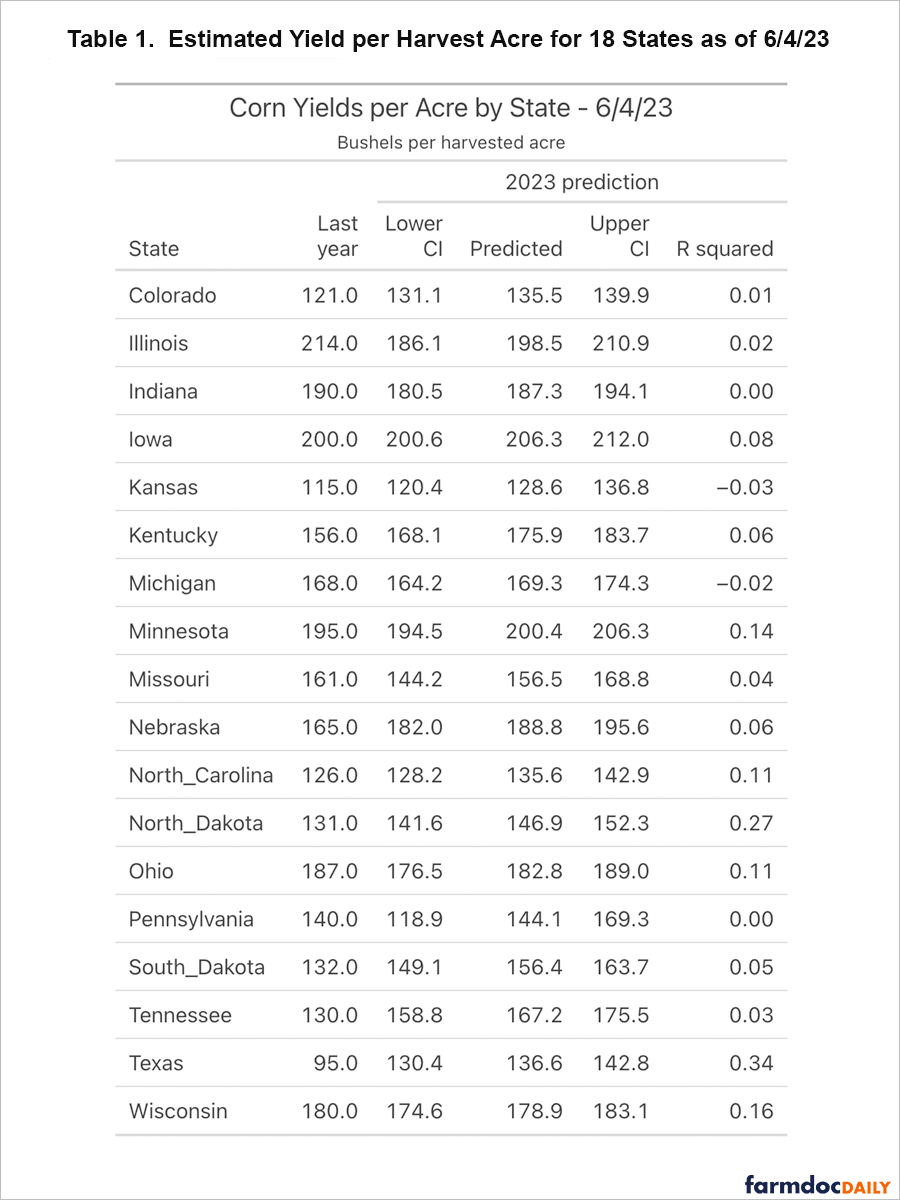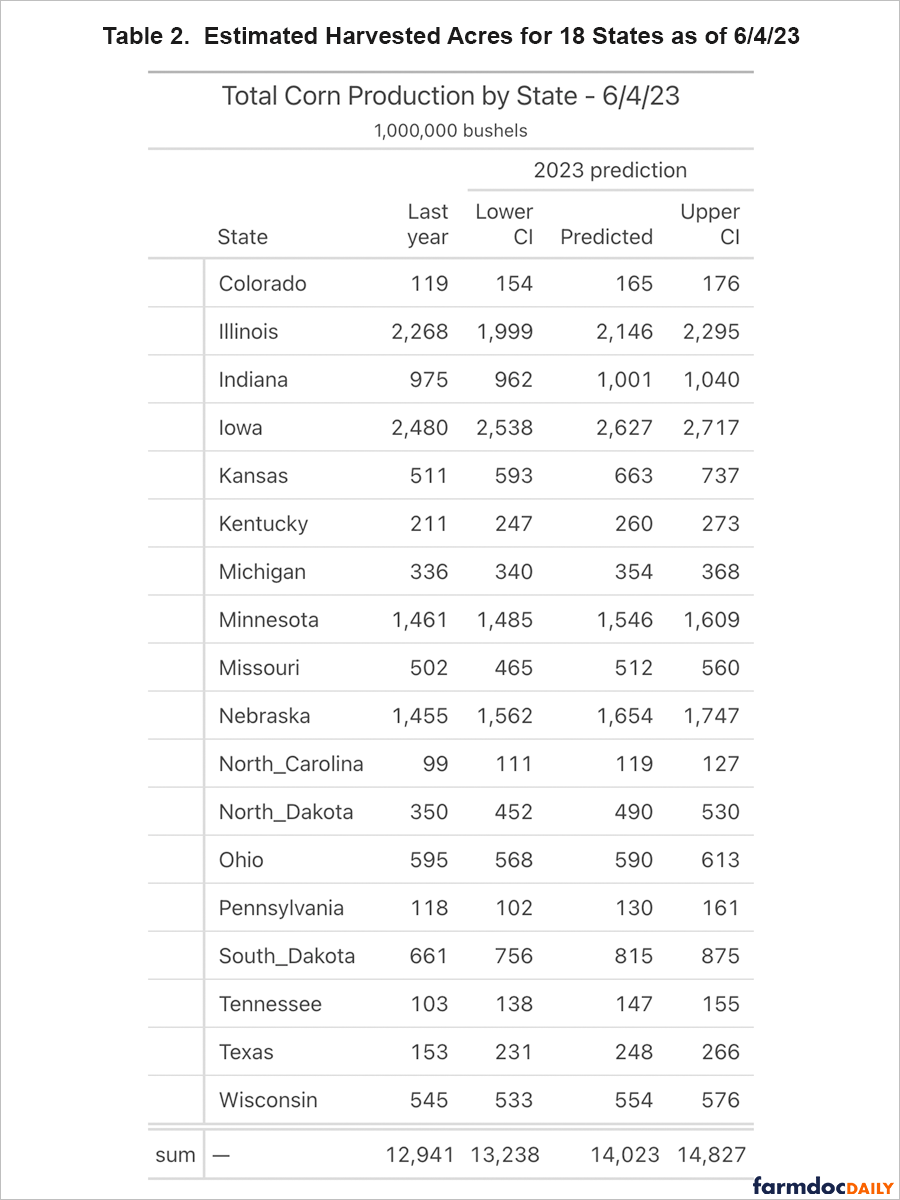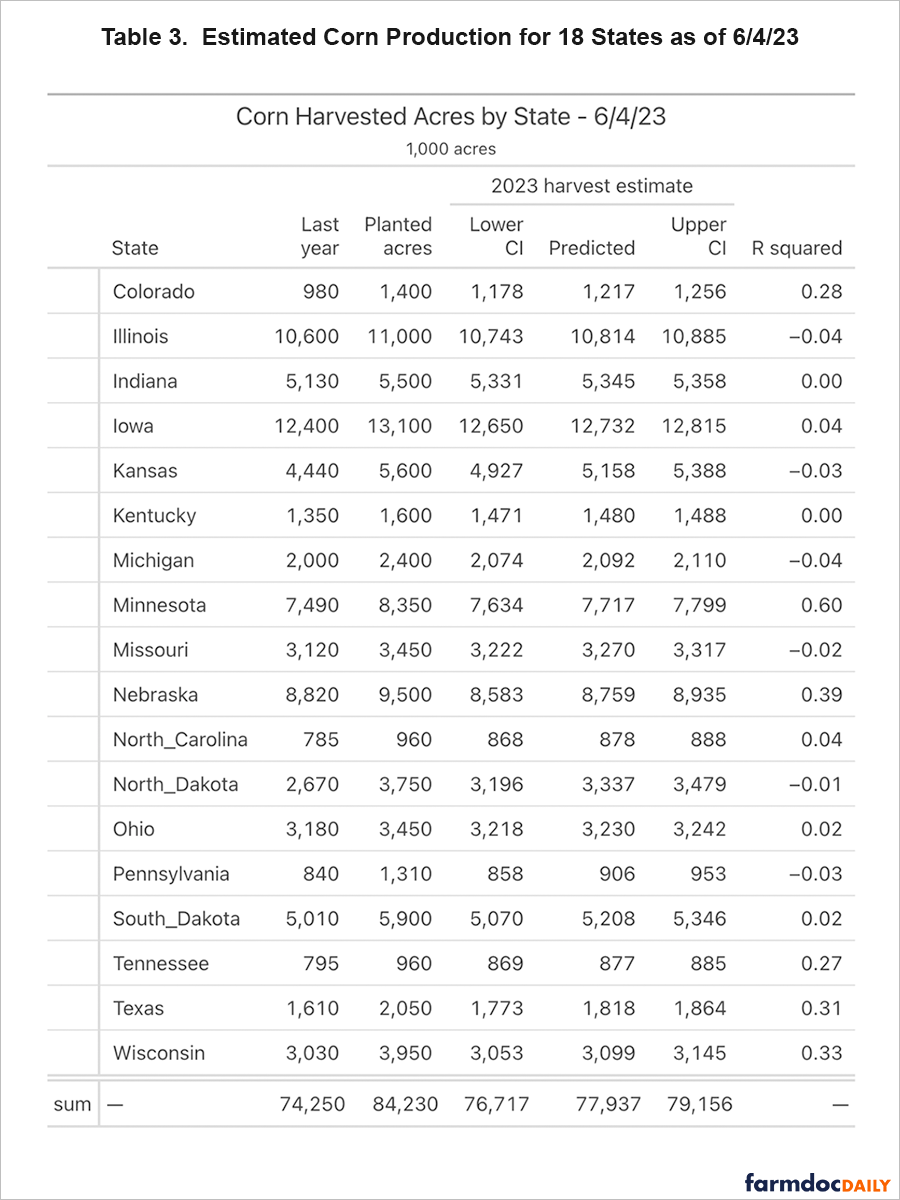A Very Early Estimate of Corn Production From the 18 Leading Corn States
Starting in June, the USDA collects weekly crop conditions from all the leading corn states. Some states have earlier estimates though. These estimates continue until harvest. The crop is rated as either: very poor, poor, fair, good, or excellent. These estimates are reported on Monday afternoons based on reports collected from the prior weekend. With only a few days between reporting and publication, this is some of the most current data available from the USDA. There are crop condition reports going back to 1986.
These weekly crop reports have been used with varying degrees of success to predict both state crop yields and harvested acres. Ibendahl (2022 and 2023) has used the data to predict state and national wheat, corn, and soybean yields, acres, and total grain production. As might be expected, the accuracy of the predictions increases as the growing season progresses. The first few weeks of crop reports have very low predictive power, and this report is no different. Irwin and Good (2017), using a different model of crop conditions, reported similar predictive accuracy early in the growing season.
Even though the predictive power of the crop report model is low at this point, this article demonstrates how the model works and provides an estimate of corn yields, harvested acres, and total production from the 18 leading corn states. The model is based on the planted acres in addition to the June 4th crop condition report. The results include the expected corn production from each state as well as the confidence interval for that estimate. To produce an estimate of corn production, both expected yields and harvested acres are estimated. The model presented here is unique as a national corn estimate is based on predicting each state’s corn acres and yield per acre from a 30-year timeline of data from a specific week during the year. The individual state estimates are then combined into a national estimate.
Procedure
As described earlier in Ibendahl (2022 and 2023), the Bain and Fortenbery model uses all five of the crop condition values in the construction of an index (CCIndex).
CCIndex = (% acreage Excellent) * 1 +
(% acreage Good) * 0.75 +
(% acreage Fair) * 0.50 +
(% acreage Poor) * 0.25 +
(% acreage Very poor) * 0
Because the crop conditions are mutually exclusive, the sum of the percent of acres across the five categories must total to 100 percent. Thus, possible index values range from 100 (if all the crop acres are excellent) down to 0 (if all the crop acres are very poor). A value of 50 would indicate the average crop condition for the state is in fair condition. The USDA provides data at the state level but not at the crop reporting district level nor at the county level.
In this analysis, the crop condition report for a specific week is used to construct a CCI index for the last 30 years (the same week from each of the 30 years). The crop conditions from the week of June 4th are used in the model reported here. These CCIndexes are then used in a regression analysis to estimate the deviation from trend line corn yield in each state. Each state is estimated individually and the yield per acre confidence interval for each state is also calculated. Because the yield estimate is based on a specific week, the model must be rerun for each week of the growing season. That is, an analysis of the crop growing conditions next week will produce a different set of parameters than the current week as the CCIndex changes from week to week for both the current and historical years.
To estimate corn production in each state, an estimate is needed of the harvested acres as well. In this analysis, the percentage of corn in the very poor category is used to estimate the percent of corn harvested acres relative to the planted corn acres. At this point, there are no USDA estimates of harvested acres. The harvested acres estimate is also unique to each week as it is also based on the 30 years of crop conditions reports at that week. In future models, this estimate of corn harvested acres will be based on USDA crop reports as they become available. The model does provide a confidence interval for the percent of planted acres that are harvested and these are incorporated into the final estimate of corn production for each state.
Results
Figure 1 is a Likert graph of the corn crop conditions for the last 20 years in the U.S. The Likert graph is centered on the fair category to make comparisons among years easier. The number along the left-hand-side of the figure is the total of the very poor and poor categories while the number along the right-hand-side is the total of the good and excellent categories. The Likert graph shown in Figure 1 indicates that corn over the last 20 years looks remarkably similar the first week of June. This graph indicates part of the reason the model has low predictive ability at this point. Corn, assuming it emerges correctly, tends to look fine initially. It may take a few weeks before any dry soil conditions start to show up in appearance.
Tables 1, 2, and 3 show the estimated yield per harvested acre, the estimated harvested acres, and the total production for each of the 18 leading corn states. As mentioned above, the fit of the model in most states is very poor at this point. The model is basically giving a trend line estimate for yield with wide confidence intervals. Similarly, the harvested acre estimate is roughly the mean of the typical harvested acre percentage of the planted acres.
Table 4 projects the 18 leading corn states acres and production into a national total for acres and production. Because the yield per acre from the individual states can’t be summed together, the shown yield per acre is calculated from the total production divided by the total harvested acres. As the table indicates, total production is expected to be 14.878 billion bushels with a range from 14.044 to 15.730 billion bushels. Harvest acres are expected to be 83.140 million acres with a range from 81.839 to 84.441 million acres. Table 4 also lists the NASS planted acres.
Important
This is the earliest a national estimate can be calculated using the USDA crop condition reports. Because it is so early, the model accuracy is very low. Readers should expect changes to the estimates as the season progresses and perhaps even significant changes depending on the amount of rain received over the growing season. Also, as noted by Irwin and Good, the earliest estimates probably tend to overestimate yields. Readers should interpret these results as production that could occur during a normal growing season.
References
Bain, R. and T. R. Fortenbery. 2013. “Impacts of Crop Conditions Reports on National and Local Wheat Markets.” Proceedings of the NCCC-134 Conference on Applied Commodity Price Analysis, Forecasting, and Market Risk Management. St. Louis, MO. http://www.farmdoc.illinois.edu/nccc134
Ibendahl, G. "An Estimate of Corn Production From the 18 Leading Corn States." farmdoc daily (12):111, Department of Agricultural and Consumer Economics, University of Illinois at Urbana-Champaign, July 27, 2022.
Ibendahl, G. "An Estimate of Winter Wheat Production." farmdoc daily (13):97, Department of Agricultural and Consumer Economics, University of Illinois at Urbana-Champaign, May 26, 2023.
Irwin, S. and D. Good. "When Should We Start Paying Attention to Crop Condition Ratings for Corn and Soybeans?" farmdoc daily (7):96, Department of Agricultural and Consumer Economics, University of Illinois at Urbana-Champaign, May 24, 2017.
Disclaimer: We request all readers, electronic media and others follow our citation guidelines when re-posting articles from farmdoc daily. Guidelines are available here. The farmdoc daily website falls under University of Illinois copyright and intellectual property rights. For a detailed statement, please see the University of Illinois Copyright Information and Policies here.












